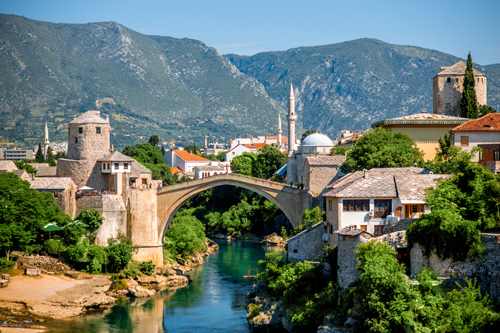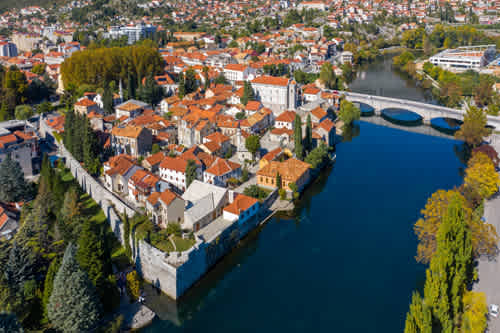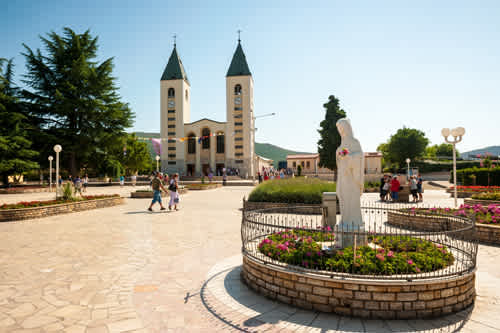Bosnia and Herzegovina, a mountainous and developing country full of beautiful nature and fascinating history, has become a popular tourist destination.
About Bosnia And Herzegovina
Sarajevo, the capital of Bosnia and Herzegovina, is firmly entrenched in the historical memory of Europe. The Miljacka River runs through the heart of the city, and the Latin Bridge that crosses it is infamous as the place where Gabrielo Princip assassinated the heir to the Austro-Hungarian throne, Franz Ferdinand, and his wife, Sophie on June 28, 1914, igniting World War I.
Bosnia and Herzegovina is full of beautiful nature, making it a great destination for trips. It is mainly a mountainous country, with peaks reaching a height of over 6560 feet, though it did also gain a small stretch of beach in the 1995 Dayton Agreement with its neighbor, Croatia.
Bosnia and Herzegovina is a developing country, giving travelers a glimpse into a variety of lifestyles, cuisine from the “good old days” at reasonable prices, and magical travel sites. It is important to be aware that the country’s roads and signage are not yet easy to navigate, and, as a result, it is recommended that travelers arrive in Sarajevo and explore the country’s attractions via one of the many organized trips. Most of the trips are 1-2 days, are reasonably priced, and depart from the city center or from individual hotels.
The country’s most popular travel destinations are in the mountains, so be sure that your physical abilities match the route of your trip – some are easy to walk while others include difficult sections. For those with reduced mobility, best to check accessibility prior to signing up for a trip. Most trips also include a meal at a local restaurant.
The recommended travel destinations are within driving distance from the capital, enabling a round trip on the same day. Not all roads have cellular service, so independent travelers should be equipped with maps and not rely only on online map services.
Here is list of some of the leading attractions in Bosnia and Herzegovina:
Mostar
The historic town of Mostar, located about 78 miles south of the capital city, lies in a deep ravine of the Neretva River. In the 15th and 16th centuries, it served as a border city of the Ottoman Empire. The ancient bridge, Stari Most, which was commissioned by the Turkish ruler Suleiman the Magnificent, was destroyed in the 1990s during the Bosnian-Croatian armed conflict and was rebuilt in 2004 along with many of the city’s homes that were damaged in battles and bombings.
On the way to Mostar, you can visit ARK/D-O, the anti-nuclear bunker used by Marshal Tito in the 1950s during the Cold War. The bunker was large enough to accommodate hundreds of Tito’s military personnel and was equipped with the best means of communication of the time, filters, water, and other essentials.
Blagaj
Located near Mostar, Blagaj is known for its outstanding natural beauty. Visit the magical Blagaj Tekija, a 600-year-old Dervish monastery located at the base of a cliff along the crystal clear waters of the Neretva River.
Kravica
The Kravica Falls are located about 25 miles south of the town of Mostar on the Trebizat River. The falls cascade to the perimeter of the river from a height of about 82 feet and produce a large area of spectacularly beautiful water.
Sutjeska
Sutjeska is Bosnia and Herzegovina’s national park and is a popular destination for many tourists. The park is located about two hours from Sarajevo, east of the border with Montenegro. The pristine reserve includes hiking trails, springs, waterfalls, and beautiful nature. In the spring, the surrounding mountain peaks are still capped with snow. The highest mountain, Maglić, rises to a height of 7835 feet and it can be seen from all around.
As most of the hiking trails in the reserve are unmarked, it is recommended to tour them only with a local guide. As some of the routes are difficult, it is important to verify before embarking that it is suitable for you and that you have the proper walking equipment.
There is a large stone monument in the reserve commemorating the victory of the partisans over the Nazis in the June 1943 battles, led by Marshal Tito, which took place there.
The Una River, a five-hour drive west of Sarajevo, is a popular kayaking and rafting destination due to its fresh, greenish water and waterfalls. The nearby city of Bihac is a great place to spend a night or two in order to be close to these activities.
It is recommended to allocate two days to explore Sarajevo. The city has a rich history from Ottoman times, through the Austro-Hungarian times, to the present day. The city’s old town is home to remaining Ottoman houses, local restaurants with enticing aromas, and cafes serving outstanding coffee that is brewed in original copper pots (Finjans).
There are cable cars available to take you up to the top of the ski slopes, which were built for the 1984 Winter Olympics. The walking paths on the mountain area are quite limited, but the beautiful view of the city located at the foot of the mountains is magical.
The Miljacka River, which was a lifeline during the city’s wars, offers boat tours. There are also remaining war tunnels and paths that are constant reminders of the years of heavy siege that the city experienced from 1992 to 1995.
Popular Itineraries
Traveled by thousands
Regions in Bosnia And Herzegovina
Attractions in Bosnia And Herzegovina
- Historic Center, Sarajevo
- Gallery 11-07-95, Sarajevo
- Bascarsija, Sarajevo
- Sarajevo Tunnel Museum
- Vijecnica (City Hall), Sarajevo
- Gazi Husrev-beg Mosque, Sarajevo
- Svrzo's House, Sarajevo
- The Jewish Museum, Sarajevo
- Sacred Heart Cathedral, Sarajevo
- Cathedral Church of the Nativity of the Theotokos, Sarajevo
- Historical Museum of Bosnia and Herzegovina, Sarajevo
- Church of the Holy Archangels Michael and Gabriel, Sarajevo
- Sebilj, Sarajevo
- Latin Bridge, Sarajevo
- Brusa Bezistan Museum, Sarajevo












